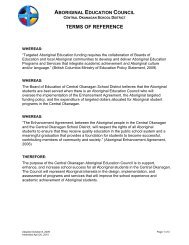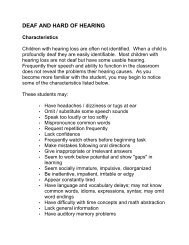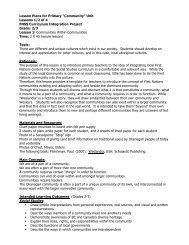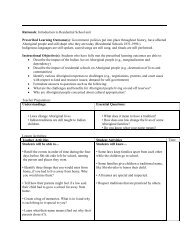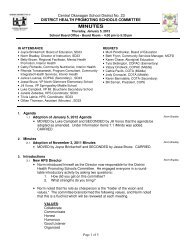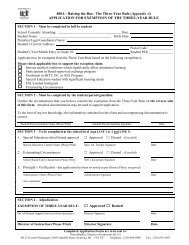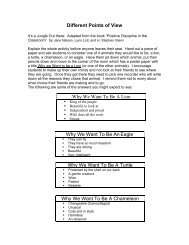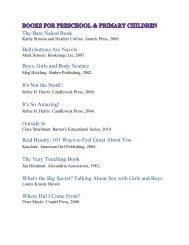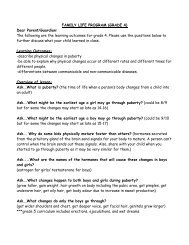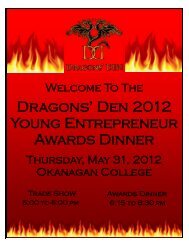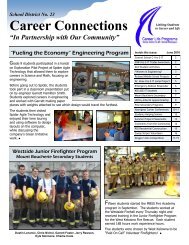Reading and Writing with Your Child, Kindergarten to Grade 6, A ...
Reading and Writing with Your Child, Kindergarten to Grade 6, A ...
Reading and Writing with Your Child, Kindergarten to Grade 6, A ...
You also want an ePaper? Increase the reach of your titles
YUMPU automatically turns print PDFs into web optimized ePapers that Google loves.
Four Top Literacy Tips for Parents<br />
Four Top Literacy Tips for Parents<br />
TIP TWO BUILD HABITS OF UNDERSTANDING<br />
The more that you read, the more things you will know.<br />
The more that you learn, the more places you’ll go.<br />
Dr. Seuss, 1978<br />
I Can Read <strong>with</strong> My Eyes Shut!<br />
You can help your child <strong>to</strong> learn about himself or herself <strong>and</strong> the world through<br />
reading – what teachers call “<strong>to</strong> read <strong>with</strong> underst<strong>and</strong>ing” – by trying out some strategies,<br />
such as these:<br />
<strong>Your</strong> child is growing up in a media-rich, technological world. Changes in society are<br />
happening so quickly that children need time <strong>to</strong> think about the underlying messages in<br />
print or in other media. Here are some ways you can help <strong>to</strong> foster critical literacy skills:<br />
• Help your child underst<strong>and</strong> the speaker’s viewpoint or perspective.<br />
• Discuss the fairness of the message <strong>and</strong> look for the misleading effects of missing<br />
information.<br />
• Talk about how language is used <strong>to</strong> persuade people – for example, talk about the<br />
powerful effects of language in advertising.<br />
• Ask if your child has learned something new that prompts new questions. Does it<br />
change what your child thinks about the <strong>to</strong>pic? How can he or she find out if it is<br />
accurate?<br />
• Asking questions. When reading <strong>with</strong> your child, ask such questions as “Why is this<br />
happening?”; “What might happen next?”; “Does this make sense?”; or “Was it fair<br />
when …?” Such questions help children make connections between parts of a s<strong>to</strong>ry.<br />
• <strong>Reading</strong> “between the lines.” To make inferences – <strong>to</strong> discover meaning that is not<br />
directly stated – your child needs <strong>to</strong> learn <strong>to</strong> use information both from the s<strong>to</strong>ry <strong>and</strong><br />
from his or her own knowledge <strong>and</strong> experience. This strategy of reading “between the<br />
lines” involves gathering clues <strong>and</strong> using them <strong>to</strong> “create” meaning.<br />
• Putting it all <strong>to</strong>gether. You can encourage your child <strong>to</strong> put it all <strong>to</strong>gether first by<br />
talking about all the information he or she has read, then summarizing the important<br />
points <strong>and</strong> putting those points <strong>to</strong>gether like pieces of a puzzle.<br />
• Figuring out difficult words. Allow your child time <strong>to</strong> figure out what a word might<br />
be or <strong>to</strong> recognize a mistake. If a mistake doesn’t affect the meaning, let it go. <strong>Your</strong><br />
child can use various tactics <strong>to</strong> figure out a word he or she doesn’t know:<br />
- Sound out the word.<br />
- Look at the pictures.<br />
- Divide the word in<strong>to</strong> smaller parts.<br />
- Reread the words before <strong>and</strong> after the difficult word.<br />
- Skip over the word for the moment <strong>and</strong> read on further.<br />
- Talk about what he or she has read so far <strong>to</strong> check underst<strong>and</strong>ing.<br />
- Ask a brother or sister for the answer.<br />
To encourage your child <strong>to</strong> read<br />
critically, ask questions:<br />
• What is this book about? Why are<br />
you interested in reading it?<br />
• What does the author of this news<br />
article want us <strong>to</strong> know or think?<br />
• Does the writer want us <strong>to</strong><br />
believe something?<br />
• What does this magazine’s theme say<br />
about children, teenagers <strong>and</strong> parents?<br />
• How has the author used words <strong>and</strong><br />
images <strong>to</strong> communicate the message?<br />
12 13<br />
<strong>Reading</strong> <strong>and</strong> <strong>Writing</strong> <strong>with</strong> <strong>Your</strong> <strong>Child</strong>, <strong>Kindergarten</strong> <strong>to</strong> <strong>Grade</strong> 6: A Parent Guide<br />
<strong>Reading</strong> <strong>and</strong> <strong>Writing</strong> <strong>with</strong> <strong>Your</strong> <strong>Child</strong>, <strong>Kindergarten</strong> <strong>to</strong> <strong>Grade</strong> 6: A Parent Guide



